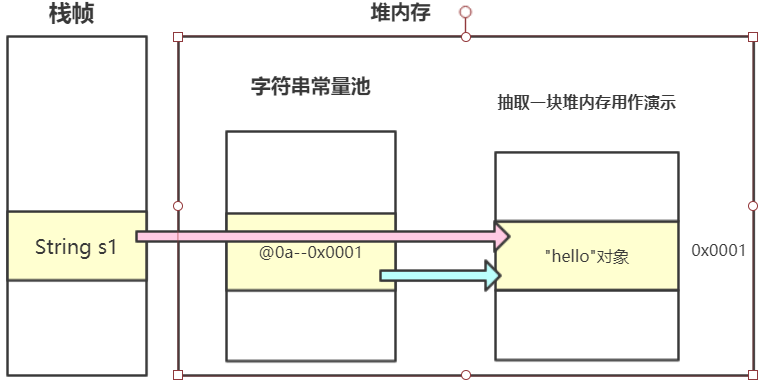Java 字符串
字符串常量池
public static void main(String[] args) {
String s1 = "hello";
String s2 = new String("hello");
System.out.println(s1 == s2);
}
|

对于这种直接通过双引号””声明字符串的方式, 虚拟机首先会到字符串常量池中查找该字符串是否已经存在. 如果存在会直接返回该引用, 如果不存在则会在堆内存中创建该字符串对象, 然后到字符串常量池中注册该字符串.
当我们使用new关键字创建字符串对象的时候, JVM将不会查询字符串常量池, 它将会直接在堆内存中创建一个字符串对象, 并返回给所属变量.
格式化字符串
String类的format()方法用于创建格式化的字符串以及连接多个字符串对象。
| 转 换 符 |
说 明 |
示 例 |
| %s |
字符串类型 |
“mingrisoft” |
| %c |
字符类型 |
‘m’ |
| %b |
布尔类型 |
true |
| %d |
整数类型(十进制) |
99 |
| %x |
整数类型(十六进制) |
FF |
| %o |
整数类型(八进制) |
77 |
| %f |
浮点类型 |
99.99 |
| %a |
十六进制浮点类型 |
FF.35AE |
| %e |
指数类型 |
9.38e+5 |
| %g |
通用浮点类型(f和e类型中较短的) |
|
| %h |
散列码 |
|
| %% |
百分比类型 |
% |
| %n |
换行符 |
|
| %tx |
日期与时间类型(x代表不同的日期与时间转换符 |
public static void main(String[] args) {
String str=null;
str=String.format("Hi,%s", "王力");
System.out.println(str);
str=String.format("Hi,%s:%s.%s", "王南","王力","王张");
System.out.println(str);
System.out.printf("字母a的大写是:%c %n", 'A');
System.out.printf("3>7的结果是:%b %n", 3>7);
System.out.printf("100的一半是:%d %n", 100/2);
System.out.printf("100的16进制数是:%x %n", 100);
System.out.printf("100的8进制数是:%o %n", 100);
System.out.printf("50元的书打8.5折扣是:%f 元%n", 50*0.85);
System.out.printf("上面价格的16进制数是:%a %n", 50*0.85);
System.out.printf("上面价格的指数表示:%e %n", 50*0.85);
System.out.printf("上面价格的指数和浮点数结果的长度较短的是:%g %n", 50*0.85);
System.out.printf("上面的折扣是%d%% %n", 85);
System.out.printf("字母A的散列码是:%h %n", 'A');
}
|
| 标 志 |
说 明 |
示 例 |
结 果 |
| + |
为正数或者负数添加符号 |
(“%+d”,15) |
+15 |
| − |
左对齐 |
(“%-5d”,15) |
\ |
15 \ |
|
| 0 |
数字前面补0 |
(“%04d”, 99) |
0099 |
| 空格 |
在整数之前添加指定数量的空格 |
(“% 4d”, 99) |
\ |
99\ |
|
| , |
以“,”对数字分组 |
(“%,f”, 9999.99) |
9,999.990000 |
| ( |
使用括号包含负数 |
(“%(f”, -99.99) |
(99.990000) |
| # |
如果是浮点数则包含小数点,如果是16进制或8进制则添加0x或0 |
(“%#x”, 99)(“%#o”, 99) |
0x630143 |
| < |
格式化前一个转换符所描述的参数 |
(“%f和%<3.2f”, 99.45) |
99.450000和99.45 |
| $ |
被格式化的参数索引 |
(“%1$d,%2$s”, 99,”abc”) |
99,abc |
public static void main(String[] args) {
String str=null;
str=String.format("格式参数$的使用:%1$d,%2$s", 99,"abc");
System.out.println(str);
System.out.printf("显示正负数的符号:%+d与%d%n", 99,-99);
System.out.printf("最牛的编号是:%03d%n", 7);
System.out.printf("Tab键的效果是:% 8d%n", 7);
System.out.printf("整数分组的效果是:%,d%n", 9989997);
System.out.printf("一本书的价格是:% 50.5f元%n", 49.8);
}
|
日期和时间字符串格式化
字符串格式中还有%tx转换符没有详细介绍,它是专门用来格式化日期和时 间的。%tx转换符中的x代表另外的处理日期和时间格式的转换符,它们的组合能够将日期和时间格式化成多种格式。
| 转 换 符 |
说 明 |
示 例 |
| c |
包括全部日期和时间信息 |
星期六 十月 27 14:21:20 CST 2007 |
| F |
“年-月-日”格式 |
2007-10-27 |
| D |
“月/日/年”格式 |
10/27/07 |
| r |
“HH:MM:SS PM”格式(12时制) |
02:25:51 下午 |
| T |
“HH:MM:SS”格式(24时制) |
14:28:16 |
| R |
“HH:MM”格式(24时制) |
14:28 |
public static void main(String[] args) {
Date date=new Date();
System.out.printf("全部日期和时间信息:%tc%n",date);
System.out.printf("年-月-日格式:%tF%n",date);
System.out.printf("月/日/年格式:%tD%n",date);
System.out.printf("HH:MM:SS PM格式(12时制):%tr%n",date);
System.out.printf("HH:MM:SS格式(24时制):%tT%n",date);
System.out.printf("HH:MM格式(24时制):%tR",date);
}
|
正则表达式
元字符
| 代码 |
说明 |
| . |
匹配除换行符以外的任意字符 |
| \w |
匹配字母或数字或下划线或汉字 |
| \s |
匹配任意的空白符 |
| \d |
匹配数字 |
| ^ |
匹配字符串的开始 |
| $ |
匹配字符串的结束 |
| \b |
匹配字符串的结束 |
重复
| 代码/语法 |
说明 |
| * |
重复零次或更多次 |
| + |
重复一次或更多次 |
| ? |
重复零次或一次 |
| {n} |
重复n次 |
| {n,} |
重复n次或更多次 |
| {n,m} |
重复n到m次 |
字符类
像[aeiou]就匹配任何一个英文元音字母,[.?!]匹配标点符号(.或?或!)。
我们也可以轻松地指定一个字符范围,像[0-9]代表的含意与\d就是完全一致的:一位数字;同理[a-z0-9A-Z_]也完全等同于\w(如果只考虑英文的话)。
import java.util.regex.*;
class RegexExample1{
public static void main(String args[]){
String content = "I am noob " +
"from runoob.com.";
String pattern = ".*runoob.*";
boolean isMatch = Pattern.matches(pattern, content);
System.out.println("字符串中是否包含了 'runoob' 子字符串? " + isMatch);
}
}
|
字符串生成器
字符串生成器即StringBuilder类,是字符串一个重要的常用类。新创建的StringBuilder对象初始容量是16个字符,可以自行指定初始长度,也可以动态地执行添加、删除和插入等字符串的编辑操作,大大提高了频繁增加字符串的效率。
如果在程序中频繁地附加字符串,建议使用StringBuilder。
public class Jerque {
public static void main(String[] args) {
String str = "";
long starTime = System.currentTimeMillis();
for (int i = 0; i < 10000; i++) {
str = str + i;
}
long endTime = System.currentTimeMillis();
long time = endTime - starTime;
System.out.println("Sting消耗时间:" + time);
StringBuilder builder = new StringBuilder("");
starTime = System.currentTimeMillis();
for (int j = 0; j < 10000; j++) {
builder.append(j);
}
endTime = System.currentTimeMillis();
time = endTime - starTime;
System.out.println("StringBuilder消耗时间:" + time);
}
}
|



